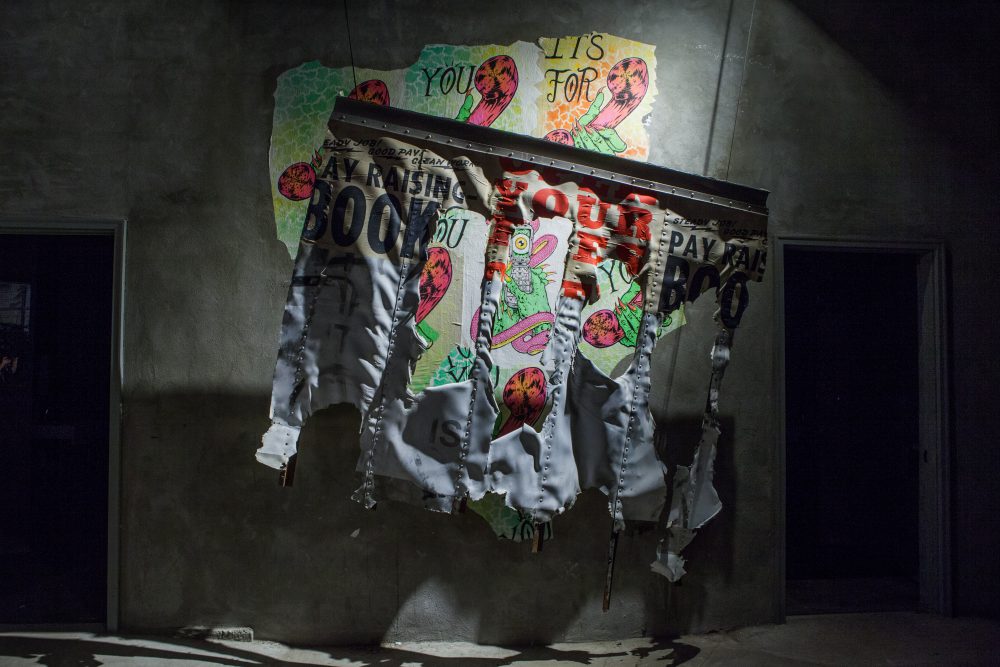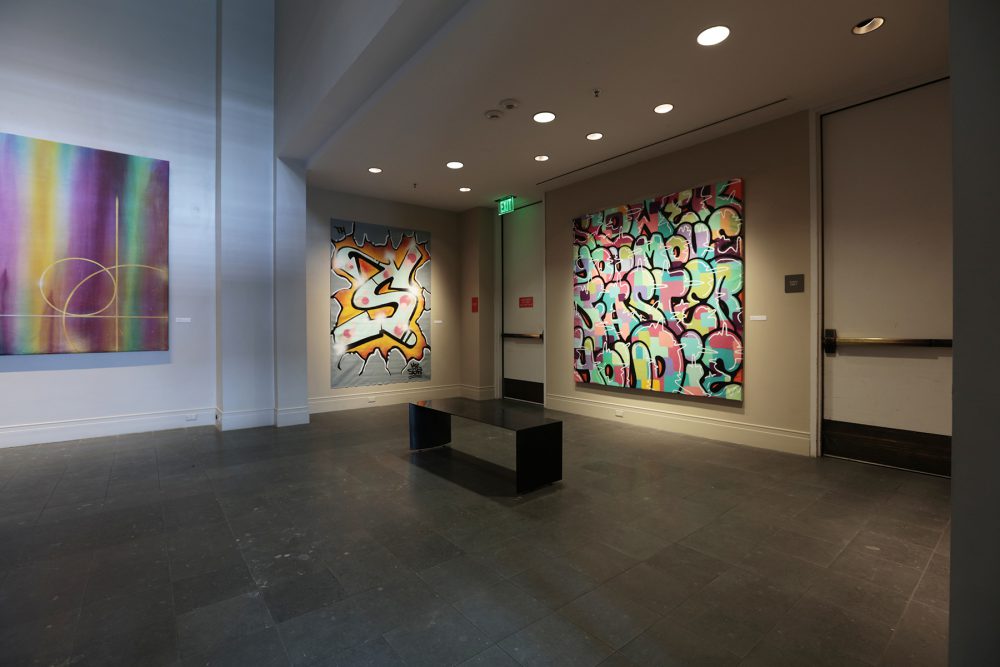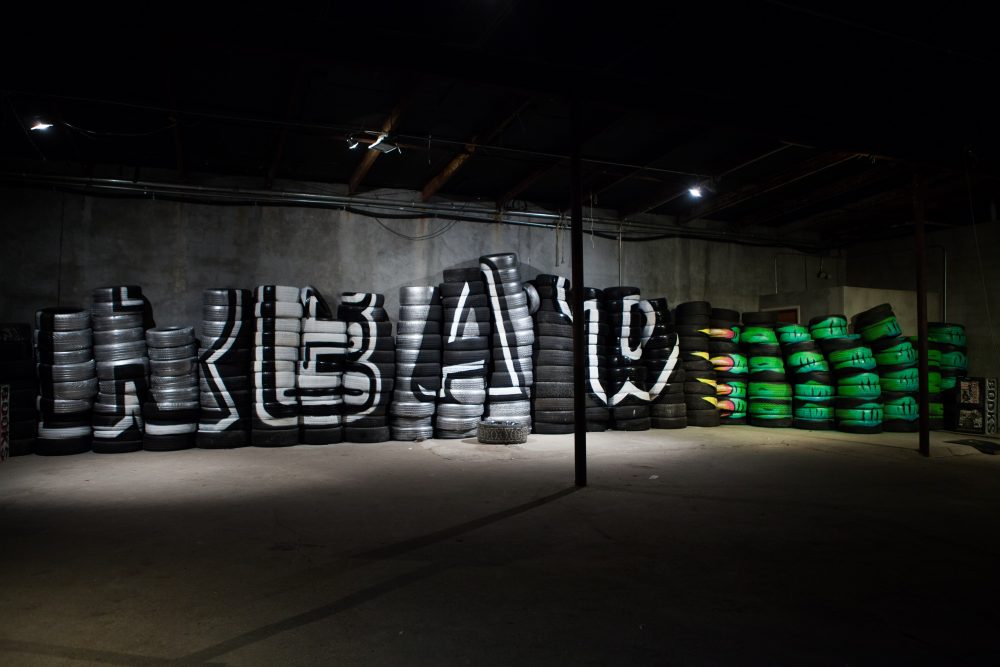Everything Dies: Graffiti from the Street to the Gallery
After visiting two recent exhibitions, Brooke Schueller contemplates the ramifications of the art world’s embrace of local street art.

Installation view of “SPECTACLES” at PORT, New Orleans. Courtesy the artists. Photo by Sarrah Danziger.
Artists like Banksy emblematize the notion that graffiti—like everything else deemed authentic, subversive, and ultimately productive in the world—is eventually subsumed by petty corporatism and the concomitant mindlessness that characterizes modern malaise. Banksy feebly critiques the system, then profits wildly from it. And yet, most graffiti exists for its own sake: It is necessarily anti-establishment in its illegality. It is unpaid work. It often lives in the bleakest public spaces, in abandoned, underserved, blight-ridden neighborhoods. It can be a bright mark of personal expression on the otherwise grey wall of our advertisement-saturated world. It has historically served as an essential testament to marginalized voices—I WAS HERE—in the most visible arenas, while simultaneously demanding anonymity on behalf of its agents. In other words, graffiti occupies the paradoxical space between the private and public spheres, between high art and low art, between destruction and creation—firmly wedging a message in the subconscious landscape of urban communities.
What is at stake, then, in the demystification of an inherently mysterious art form through its transition from the streets to the gallery, the museum, the warehouse-turned-art-space? Is it a triumph of image over substance? Is it selling out? Or is it garnering respect and regard for the rich history of a deeply nuanced art form?

Installation view of “Top Mob: A History of New Orleans Graffiti” at the Ogden Museum of Southern Art, New Orleans. Courtesy the artists.
A PLEA FOR MYSTIQUE
“Top Mob: A History of New Orleans Graffiti” at the Ogden Museum of Southern Art introduces graffiti as “the oldest form of art.”
“One of the biggest challenges with presenting a retrospective of graffiti,” the the wall text continues, “is convincing you, the viewer, that the subject, largely considered simple vandalism, has a complexity and depth that makes it worthy of examination and respect.”
The exhibition presents hundreds of grainy four-by-six photos posted along a timeline stretching from 1984—when Top Mob, New Orleans’ oldest graffiti crew, surfaced—to present day. An accompanying glossary outlines technical terms, a sterile academic deconstruction. Along the thirty-year trajectory, graffiti writers’ names are matched with their styles and narratives of their arrivals to and departures from the scene. Many of the writers eventually transitioned from tagging to fine art, to jewelry making, to graphic design, to arts education, or—as one writer was said to have done—to a fraternity at LSU after giving up on the girl he was trying to impress.
In this light, the heap of Top Mob blackbooks—once well-guarded photographic portfolios of a writer’s collected output, housed here in a glass case—look more like bonfire fodder in some dystopian novel. The newly commissioned pieces by several of Top Mob’s members seem hokey at best, if not outright soft, particularly when framed by the curators’ mawkish assertion that the exhibition is their response to the notion that graffiti is vandalism.
If your grandma, puttering around in an electric wheelchair, can appreciate graffiti in this context (An elderly, nice-looking woman said, “Oh! No doubt about it, they are artists!”), then you can probably stick a fork in it and call it done. One graffiti writer, AXE ONE—quoted somewhere in the ’90s section of the timeline—put it thus: “If you want to do hood sh*t, sometimes you have to pay the tax.”

Installation view of “SPECTACLES” at PORT, New Orleans. Courtesy the artists. Photo by Sarrah Danziger.
“DON’T INVITE ME IN FROM THE JUNGLE AND NOT EXPECT TO GET DIRT ON THE FLOOR”
“SPECTACLES,” a collection of works by New Orleans-based graffiti writers READ and YOU GO GIRL opened last month at PORT during termite season. One of the first swarms of the year descended upon the open-air warehouse in such a multitudinous assault that the prints in the interior, upper level were nearly inscrutable. Tellingly, it was a show best glimpsed from the shadows.
In a post-Katrina landscape where many people assumed most everything was up for grabs, READ and YGG emerged as bright spots amidst the bleakness, their pieces shouting from the rooftops, from shuttered houses, and from abandoned billboards. (READ, incidentally, is included in Top Mob’s ranks, as evidenced in the Ogden retrospective.)
They are examples of the rare, but happy, marriage of art that is not only hip, but also socially productive. Using materials that look like they were scavenged from a post-apocalyptic fallout, READ touts the value of PAY RAISING BOOKS; he urges viewers to O.Y.E. (OPEN YOUR EYES); he advertises the WIDE-AWAKE CLUB. YGG encourages all spectators, irrespective of their origins, motivations, or desires, in the same dripping, cartoonish palette: YOU GO GIRL.
In an interview with The Gambit, YGG calls the chance to bring works off the street “a completely different animal”—and why wouldn’t it be? “SPECTACLES” presents an array of works that don’t belong on the streets, like YGG’s Baba Yaga’s House sculpture, which sits on a pair of metal chicken feet in homage to the Russian folktale. Her signature, sharply manicured monster hand creeps across asymmetrical stacks of tires. YOU GO GIRL is cut out from a bird made of corrugated tin, wings outstretched, and illuminated against the wall. Smattered across prints is the same monster hand, clutching a phone, with the spindly text: IT’S FOR YOU. The two artists are given the opportunity to stray from the repetition of tag-oriented street graffiti: It’s an expansion, not a dilution, of their art.
Responses from people I spoke with ranged from the thrill of accessibility (“My partner and I bought a t-shirt instead of a print to hang on the wall”) to tepid disregard for the art world (“I could kinda just go to the train tracks instead”). Regardless, the collection of works, presented thusly, is nothing short of a spectacle: We, the spectators, encounter what are ordinarily isolated bricks in our visual subconscious as a fully formed wall. We witness its contours in full, as an overarching body of work.
Is “SPECTACLES” “underpinned by satire and institutional critique” as touted in the event description? Meh. Granted, we’re not encountering the works somewhere as clean-cut as the Ogden Museum, a Julia Street gallery, or some whitewashed Brooklyn interior. The works are affordable, relatively speaking. The message is sound, still intact.
In a world unrelentingly steered by dynamism, how dull it is to lament the death of one art form. Things die. New things are born. We may not always agree about the direction of said dynamism, and a little bit of griping does serve as an effective rudder in ensuring that the dynamism is indeed productive.
Is graffiti dead? I doubt it. Is it oversaturated with posers? Seems like it. Is commercial appreciation decimating graffiti’s artistic and political value? Probably. Do the artists deserve to make money? Sure. Will READ or YGG ever strike the same radical chord they did just after Katrina? Who knows. Will there be other artists who emerge to push the genre along? Most definitely. Do we know what that’ll look like? Not necessarily.
In the meantime, I will take my art with a swarm of termites. I will READ MOTHERFUCKING BOOKS, ALL DAMN DAY. And I will pump my slimy cartoon fist in the air each time I cross a YOU GO GIRL. The medium is malleable, but the message, thankfully, is not.
Editor's Note
“Top Mob: A History of New Orleans Graffiti” is on view through November 6, 2016, at the Ogden Museum of Southern Art (925 Camp Street) in New Orleans. “SPECTACLES” is on view through June 24, 2016, at PORT (2120 Port Street).



